This section covers some of the most commonly used medicinal plants used in the Ayurvedic tradition of Nepal.
Agaru or Aguru wood (eaglewood / krishnagaru / Aquilaria agallocha)
Agaru is a tropical and sub-tropical, fragrant evergreen tree. The wood is very heavy, and sinks in water. The wood is bitter in taste, hot in action, and used in asthma. It has a second variety, black in color, called krishnagaru. It reduces Vata and Kapha. It is also an alterative used for rejuvenation (Rasayana), and is a specific for Vata spasmodic asthma. It is also used in brain defects, and for eye, ear and skin diseases. For any disease resulting from cold it is used in the form of incense to create heat in the body, especially in the chest and head areas.
Agnimantha bark/root/leaf (Premna integrifolia)
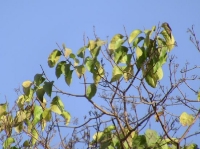 Agnimantha is a tropical and sub-tropical thorny tree with aromatic leaf, found in the mountains. There are two varieties used, large and small. The bark and root are bitter and pungent in taste, and used for edema, urinary diseases, neurasthenia, and to reduce Vata. The alkali extracted from the ash of the bark is used in ascites. It is a strong digestive medicine.
Agnimantha is a tropical and sub-tropical thorny tree with aromatic leaf, found in the mountains. There are two varieties used, large and small. The bark and root are bitter and pungent in taste, and used for edema, urinary diseases, neurasthenia, and to reduce Vata. The alkali extracted from the ash of the bark is used in ascites. It is a strong digestive medicine.
Aila or Ela fruit/seed (greater cardamom / Amomum subulatum)
Aila is an annual tuberous plant cultivated in temperate and sub-tropical valleys. The seed (fruit) is pungent in taste, light and dry in property aromatic, and has a cooling sensation. It reduces Kapha and Pitta defects. It is carminative, appetizing, sedative and an aid in digestion. It is used as a mild anti-poison in body for aches, coughs, and vomiting. It is also good for mouth diseases and nausea. Aila is a good spice for bean and meat preparations, and can be used after meals for its pleasant aroma.
Ajamoda seed (wild celery / Carum roxburghianum)
Ajamoda is a biennial herb that grows everywhere. The seed is pungent in taste. It aids in rheumatism and gout by reducing pain (Vata) and swelling (Kapha). It is a strong digestive aid, used as part of the classic Hingastaka churna digestive formula. The whole seeds can be chewed to stimulate agni, the digestive fire. Because of its strength, the dose is very small when used alone or in combinations. Ajamoda has a stimulating action on the respiratory system and acts as a decongestant and expectorant. Ajamoda is used for colds, flu, laryngitis, bronchitis, asthma, cough, colic, indigestion, edema, and arthritis. Also used for bladder pain and abdominal colic.
Alarka or Arka flower/latex/leaf/stem (milkweed / arka / Calotropis gigantia, white/red)
Alarka is a stout medium size shrub that comes in two varieties, one with white flower and one with pink-red flower. Both flowers have an alkaline taste. The white flower, leaf and stem are used for leprosy, itching, detoxification of poisons (especially rat poison), abscess, worms, tumors and liver and spleen diseases. The pink flower is used for digestion, nausea, asthma, and hemorrhoid. The latex that is salty and bitter in taste, is used for constipation, tumor, and hemorrhoid. The salt made from the leaf of this plant is used for constipation and for liver and spleen diseases.
Amalaki or Amalakam fruit (Indian gooseberry / amla / Phyllanthus emblica)
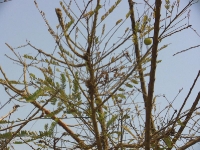 Amalaki is a tropical and sub-tropical middle sized tree that grows in dry areas. The fruit is sour, sweet and astringent in taste, and cooling in action. It is a heart restorative, and a Rasayana when used over a long period of time. It is used in bronchitis, cough, fever, alcoholism, and hemorrhage. It reduces Vata, Pitta and Kapha. It is also used for anemia, asthma, burning sensation, lung disease, and cancer. It is part of Triphala, where it is mildly laxative. It is tridoshaghna, an agent that stimulates the brain to subdue the over-balanced body systems.
Amalaki is a tropical and sub-tropical middle sized tree that grows in dry areas. The fruit is sour, sweet and astringent in taste, and cooling in action. It is a heart restorative, and a Rasayana when used over a long period of time. It is used in bronchitis, cough, fever, alcoholism, and hemorrhage. It reduces Vata, Pitta and Kapha. It is also used for anemia, asthma, burning sensation, lung disease, and cancer. It is part of Triphala, where it is mildly laxative. It is tridoshaghna, an agent that stimulates the brain to subdue the over-balanced body systems.
Amlavetasa rhizome/fruit (rhubarb / Rheum emodi)
Amlavetasa is an annual alpine plant. Its rhizome and stem are sour in taste and warming in action. It is strong, light to digest and dry in property. It reduces Vata and Kapha. It is a laxative. It is used for cirrhosis of liver, alcoholism, neurasthenia, gas, asthma and for cleaning the ducts. The fruit is sour in taste and used as a heart restorative, for urinary diseases and tympanitis, and strong enough to help in the digestion of the fat of sheep, wild boar or pigs. Because of its strong sour taste, it is used only in small amount, and overdose can cause blood defects and Pitta and Kapha defects.
Apamarga herb/root/seed/ash (Achyranthes aspera)
Apamarga is a temperate annual small herb that grows in shady areas. The whole plant, root, seed and ash are used. It comes in two varieties, green and red. Apamarga is bitter and pungent in taste, light to digest, strong and dry in property, and warming in action (green). It reduces Kapha and Vata. Used as an erhine snuff to reduce nasal mucus and relieve headache. The alkaline ash is used in eardrops (ash and water boiled with sesame oil) for otitis media as well as nosebleeds. It is emetic in large doses. According to tridosha principles, green apamarga is good for Kapha and Vata diseases, while red apamarga sometimes shows opposite action because it has a cooling action. Both varieties are good for defects of fatty tissue, skin diseases, and stomach diseases. The seed of red apamarga is good for hemorrhage (raktapitta).
Adrakam root (ginger / sunthi / Zingiber officinalis)
Ginger root is an erect cultivated perennial spicy plant with thick tubers. It is very pungent (hot) in taste, carminative and an aid to digestion. It is cooling in action. It is light to digest and strong in property. It reduces Kapha and Vata. It is used for urticaria, common cold, allergies, asthma, cough and rheumatism. It is also a heart restorative. Its post-digestive action is sweet (madhura), increasing its nourishing qualities and creating a mild aphrodisiac effect as well as aiding in peristaltic movement. It is a good spice for everyone (all body types), though excessive use is not good in micturia, pitta diseases, ulcer, fever, or during the summer or autumn seasons. Dried ginger is called Sunthi.
Arjuna bark (Terminalia arjuna)
Arjuna is a large perennial tree that grows in the mountains of temperate climate. The bark is astringent in taste, and cooling. It reduces Kapha and Pitta defects. It is a strong heart restorative, an anti-poison, and has medicinal value for healing wounds. It is also used for lymph swelling.
Ashwagandha root (Convolvulus arvensis / Withania somnifera)
There are two different plants which are called by the Sanskrit name Ashwagandha. Both are effective. Convolvulus arvensis is a perennial bushy plant with white roots that grows in tropical areas. Withania somnifera is a small to middle-sized shrub that flowers throughout the year. The root of both plants is bitter in taste, and a powerful Rasayana. It is aphrodisiac and reduces Vata and Kapha. It is used for any Vata (nervous system) disease, and to increase weight. It increases mother’s milk production. It is used for nervous exhaustion, poor memory, weakness of muscles and impotence. Used as a nerve restorative when combined with Gokshura fruit.
Ashoka bark/leaf/flower (Ashoka tree / Saraca indica)
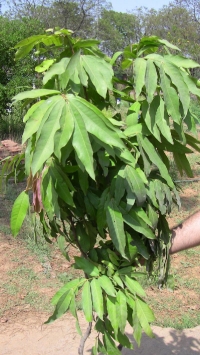 Ashoka is an evergreen tree that grows tropical and sub-tropical areas. The bark is astringent and bitter in taste, and constrictory in action. It reduces Pitta. It is used for menorrhagia and bleeding, especially uterine bleeding.
Ashoka is an evergreen tree that grows tropical and sub-tropical areas. The bark is astringent and bitter in taste, and constrictory in action. It reduces Pitta. It is used for menorrhagia and bleeding, especially uterine bleeding.
Atibala plant (Sida rhombifolia)
Atibala is an annual bushy plant with yellow flowers. All parts are sweet in taste. It is part of the Bala group. It reduces Vata and is used for nervous system diseases.
Ativisha tuber, purified (aconite / Aconitum heterophyllum)
Ativisha is an alpine tuberous herb. It is very toxic and must be purified before use by steaming in cow or goat’s milk for three hours. Purified Ativisha tuber is bitter and pungent in taste, light and dry in property, and heating in property. It is used as an anti-poison for fever, diarrhea, toxemia, and dysentery. Single dosage in an adult should not exceed 10 mg.
Bala plant (country mallow / Sida cordifolia)
Bala is an annual small plant with yellow flowers that grows in dry areas. It is part of the Bala group. All parts of the plant are sweet in taste, hot in action (Virya), Balyam (restores tone and increases energy) and Rasayana to promote long life and good health. It reduces Vata. Bala has a generalized activating effect on the nervous system by increasing both blood circulation and nourishment. It has medicinal value in treating neuropathy related with any organ. It is also used for tuberculosis for healing the lung, as well as chronic bronchitis and hemoptisis. It can be mixed into oil and used as a massage useful for muscle stiffness caused by Vata.
Bhringaraj (Eclipta alba, Widelia calendulacea)
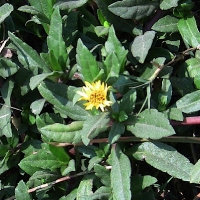 Bhringaraj is a small annual cultivated vegetable that also grows wild in moist areas and during the rainy season. It has two varieties, one with white flowers (Eclipta alba), and one with yellow flowers (Widelia calendulacea). All parts of the plant are pungent and bitter in taste, light to digest and dry in property, and hot in action. It reduces Vata and Kapha dosha and is a Rasayana. In nasya (snuff) form it is used in sinusitis, migraine, and diseases of the head, eye, nose, throat and ear. For these purposes it is usually added to sesame oil and dropped in the nose. The leaf juice is a rejuvenative and deobstructant of the liver used in liver and spleen enlargements, fevers, dropsy, anemia and skin diseases. To make the hair black and luxuriant, boil the leaf juice with sesame or coconut oil and apply externally. A paste of the plant mixed with sesame oil is used over glandular swellings, elephantitis, and skin diseases.
Bhringaraj is a small annual cultivated vegetable that also grows wild in moist areas and during the rainy season. It has two varieties, one with white flowers (Eclipta alba), and one with yellow flowers (Widelia calendulacea). All parts of the plant are pungent and bitter in taste, light to digest and dry in property, and hot in action. It reduces Vata and Kapha dosha and is a Rasayana. In nasya (snuff) form it is used in sinusitis, migraine, and diseases of the head, eye, nose, throat and ear. For these purposes it is usually added to sesame oil and dropped in the nose. The leaf juice is a rejuvenative and deobstructant of the liver used in liver and spleen enlargements, fevers, dropsy, anemia and skin diseases. To make the hair black and luxuriant, boil the leaf juice with sesame or coconut oil and apply externally. A paste of the plant mixed with sesame oil is used over glandular swellings, elephantitis, and skin diseases.
Bhutakesi herb (Valeriana wallichii)
Bhutakesi is an alpine and sub-alpine small strong smelling herb that grows in shady areas. All parts of the plant are bitter in taste. It is an anti-poison used in throat defects (such as swelling in the throat and mouth) and malaria. It is used as an anti-poison in swelling caused by toxins or gout and in malaria. It is also used as a calmative in formulas for high blood pressure, epilepsy and insomnia. It is used as an antispasmodic incense in asthma, hiccough, and cough and to calm the mind and brain. Overdose is emetic.
Bibhitaki fruit (Terminalia belerica)
Bibhitaki is a large tree that grows in sub-tropical mountainous climes. The fruit is sour and astringent in taste, and mildly laxative. It reduces Kapha and Pitta, and is used in cough and fever. It is a Rasayana and part of Triphala, the three fruits compound.
Bijaya leaf (hemp / bhang / Cannabis sativa)
Bijaya is an annual plant with a tough fibrous inner bark. All parts of the plant are bitter and pungent in taste, and hot in action. Used as a pain killer, antispasmodic and aphrodisiac. It helps in diarrhea and summer colds. It is vyavayi, an intoxicating agent that first starts to affect the body, and then later strengthens digestion.
Bilwa fruit/root/leaf/root bark (bael / vilwa / Aegle marmelos)
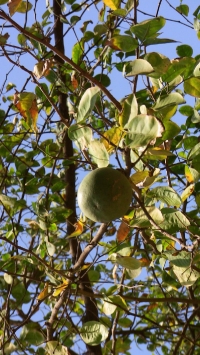 Bilwa is a tropical and sub-tropical middle sized thorny tree that fruits in all seasons. Bilwa is warming in effect, carminative and it reduces Vata dosha. The raw unripe fruit is sweet and astringent in taste, and is used especially in diarrhea, dysentery, chronic sprue, and amoebic dysentery. The root and leaf are bitter and astringent in taste. The root bark is bitter in taste and is used in nerve disorders to reduce pain. It is a very good digestive restorative.
Bilwa is a tropical and sub-tropical middle sized thorny tree that fruits in all seasons. Bilwa is warming in effect, carminative and it reduces Vata dosha. The raw unripe fruit is sweet and astringent in taste, and is used especially in diarrhea, dysentery, chronic sprue, and amoebic dysentery. The root and leaf are bitter and astringent in taste. The root bark is bitter in taste and is used in nerve disorders to reduce pain. It is a very good digestive restorative.
Brahmi leaf/root (gotu kola / Hydrocotyle asiatica /Centella asiatica)
Brahmi is an annual (perennial) small spreading plant that grows near rivers and ponds. All parts of the plant are bitter in taste and cooling in action (Virya). It is used in epilepsy, to improve memory and concentration and to prevent miscarriage. It is also an anti-poison and good for throat hoarseness.
Brihati shrub (vrihati / Solanum indicum)
Brihati is an annual thorny plant that grows in the plains areas. All parts of the plant are sweet in taste. Used in fever, typhoid fever, throat defects, coughs and edema. It is an anti-poison.
Chakramarda seed/leaf (taper / Cassia tora)
Chakramarda is a perennial bush that grows in temperate climates. The seed is pungent in taste, warming in action, light to digest and dry in property. It is germicidal, and is used for ringworm and skin diseases. The leaf is sour in taste, hot in action, and used as an external plaster for ringworm. For skin eruptions or itching, grind the leaf or seed with sour buttermilk or lime juice.
Chandana wood (white sandalwood / Santalum album)
White sandalwood is a tropical tree with aromatic wood. The wood is bitter in taste, and cold in action. Used as a refrigerant to reduce Pitta, effective for fever, dizziness, heat sensations, menopausal hot flashes etc. It also works as an anti-poison (visaghna) in the case of various types of poisoning.
Chavyam fruit/stem (Piper chava)
Chavyam is a sub-tropical creeper that grows in the shade in forests. The stem is pungent in taste, and appetizing. Used in asthma, coughs, abdominal colic and to reduce Kapha. It is dipanam, an agent that increases appetite, but does not aid digestion. Note: Chavyam is the whole plant, and Gajapippali is the fruit. The fruit is pungent in taste, hot in action, appetizing and digestive. It reduces Vata and Kapha.
Chitraka root (leadwort/ Plumbago zeylanica)
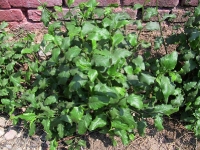 Chitraka is a bushy plant that grows in temperate and sub-tropical climates. There are two varieties, one with white flower and another with blue flower. Both are used, but the blue flower variety is considered more potent. The root and stem are pungent in taste, hot in action (Virya), digestive and appetizing (dipana-pachanam). They reduce Vata and Kapha. It is used for worms, abdominal colic, abdominal tumor, edema, anemia, hemorrhoids without bleeding, and obesity.
Chitraka is a bushy plant that grows in temperate and sub-tropical climates. There are two varieties, one with white flower and another with blue flower. Both are used, but the blue flower variety is considered more potent. The root and stem are pungent in taste, hot in action (Virya), digestive and appetizing (dipana-pachanam). They reduce Vata and Kapha. It is used for worms, abdominal colic, abdominal tumor, edema, anemia, hemorrhoids without bleeding, and obesity.
Dadima rind/fruit (pomegranate / Punica granatum)
Dadima is a small cultivated tree. Pomegranates come in two varieties: sweet-astringent, and sour-astringent. The rind is astringent in taste, and cool in action (Virya). It is used as a rejuvenative for anemia. It increases mother’s milk production. The fruit is easy to digest, carminative, nourishing to the heart and is helpful to digestion. The sweet-astringent variety has medicinal value in treating diarrhea, alcoholism, indigestion and heart problems. The sour-astringent variety is more effective in treating indigestion and alcoholism.
Danti seed/root (Baliospermum montanum)
Danti is a small-sized evergreen tree that grows in the tropical climate. Danti is pungent in taste and a strong purgative. It is used in hemorrhage, and is good for any stomach disease.
Daruharidra bark/extract (barberry / Berberis aristata / B. nepalensis)
Daruharidra is a perennial spiny shrub (aristata) or small tree (nepalensis) with thorny leaves and yellow wood. It grows in the sub-alpine to temperate mountainous climates. The root bark, often made into a condensed extract called Rasanjana, is bitter and astringent in taste, light to digest and dry in property, and hot in action. Its post-digestive action is pungent (katu), causing a drying effect in the colon. It reduces Kapha and Pitta. The condensed paste is boiled in water and used as eyewash for conjunctivitis, as a gargle for mouth sores or infections, and as drops for infections of the nose and ears. Also used as a vaginal wash for leucorrhea. Externally the paste can be used for skin fungus, sores and to speed wound healing. Taken internally it is used in urinary diseases with pus and for infections.
Devadaru bark (Himalayan cedar / Cedrus deodara)
Devadaru is an alpine and sub-alpine evergreen with aromatic bark. Devadaru bark is bitter in taste, aromatic, and warming in action. It is used for fever and constipation, and to reduce Vata and Kapha. It is also used for bloated stomach, sinusitis, and urinary diseases.
Dhanyakam seed (coriander / Coriandrum sativum)
Dhanyakam seed is pungent in taste, carminative, digestive and refrigerant. It is pachanam, a digestive agent that increases digestive power, but does not increase appetite. It is good for thirstiness, burning sensation, nausea and worms. The green vegetable form is especially good for Pitta disorders.
Duralambha bush (Fragonia cretica)
Duralambha is an alpine and sub-alpine thorny bush. All parts of Duralambha are bitter, sweet and astringent in taste, and cooling in action. Used in fever, hay fever, bronchitis, intoxication and dizziness. It reduces pittaja blood defects. It has another variety that grows in the desert, called Yasa (Alhagi maurorum).
Ghrita (ghee / clarified butter)
Ghrita is made by heating butter and discarding the curds that fall to the bottom. It is considered to be the best of all oily foods, and is used to cure disturbances in Pitta and Vata. It enhances quantity and quality of Oja (vital fluid) and strengthens digestion (agni) while reducing Pitta. Ghee also promotes memory and intelligence by nourishing the brain as well as the subtle tissues of the body. It is used as a preferred carrier (anupanum) for herbs used to reduce Pitta.
Gokshura fruit (Tribulus terrestris)
Gokshura is an annual spreading small herb with thorny seeds. The fruit is sweet in taste and hot in action (Virya). It reduces Vata (nervousness) and is a Rasayana good for energy and long life. It is especially good for urinary diseases (Mutraroga), and is used for edema, cystitis, cough, kidney and bladder stones and fever. It becomes a nerve rejuvenative when combined with Ashwagandha root.
Guduchi stem (Tinospora cordifolia)
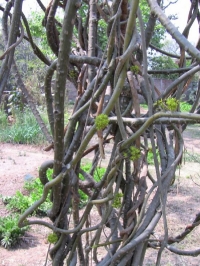 Guduchi is a long creeper that grows in temperate and sub-tropical forests. The stem is bitter in taste and warming in action. It is a Rasayana, for good health and longevity, as well as being an anti-toxin. It reduces Vata and Pitta. It is used for fever due to cold, including malaria fever, as well as to remove toxins in hepatitis, gout, toxemia, and urinary diseases. It is diuretic and aphrodisiac, useful in impotence. It has the prabhava (special power) called samanam, meaning it restores balance, but never causes over-balance.
Guduchi is a long creeper that grows in temperate and sub-tropical forests. The stem is bitter in taste and warming in action. It is a Rasayana, for good health and longevity, as well as being an anti-toxin. It reduces Vata and Pitta. It is used for fever due to cold, including malaria fever, as well as to remove toxins in hepatitis, gout, toxemia, and urinary diseases. It is diuretic and aphrodisiac, useful in impotence. It has the prabhava (special power) called samanam, meaning it restores balance, but never causes over-balance.
Guggulu gum resin (Balsamodendron mukul)
Guggulu is a small tropical, thorny tree with aromatic gum. The gum is bitter-pungent in taste, hot in action and alterative. It is also a Rasayana for long life and health. It reduces Kapha and Vata. It is used for abnormal growth, tumors, cysts, arthritis, glandular swelling, cancer, and inflammation. It is frequently used with Triphala (three fruits compound) and/or Guduchi stem.
Haridra root (turmeric / Curcuma longa)
Haridra root is a common cultivated spice. It is bitter, pungent and hot in taste, warm in action (dilates capillaries), and light to digest and dry in property. It reduces Kapha and Pitta. As a spice it is beneficial for all food preparations, used specifically to prevent food poisoning. Used for skin and urinary diseases, for liver diseases (including hepatitis), and for inflammation with swelling (including sinus). Used externally for skin diseases and as a plaster for swelling. It has an especially beneficial effect upon Kapha energy.
Haritaki fruit (chebulic myrobalan /Terminalia chebula)
Haritaki is a sub-tropical middle-sized mountain tree. The fruit is sweet, sour, astringent, pungent, and bitter in taste, and hot in action. It contains all tastes except for salty. It is a Rasayana, good for long life. It reduces Vata and Pitta, and is part of Triphala (three fruits combination). It is a “mild laxative that aids digestion” (anulomanum), and due to its rejuvenative properties is a good laxative for weak or elderly patients. It is used both internally and externally to nourish heart, liver, kidney and eye. It is especially and extensively used in urinary diseases.
Hastikarnapalasa seeds/root (bastard teak / Butea monosperma)
Hastikarnapalasha is a sub-tropical annual bush with large leaves and a thick root. The seed is bitter in taste and used as an anthelmintic, especially effective in roundworm. The root is used in goiter.
Hingu gum (asafoetida / Ferula narthex)
Hingu is a tropical, thorny bush with a strong aromatic gum. The gum resin is bitter in taste, carminative and an appetite stimulant. It is an agent that helps neutralize gas-forming properties of beans (Vataghna), and is used in flatus and colic pain.
Hriverum plant (Pavonia odorata)
Hriverum is a temperate annual plant with aromatic leaves that grows on the shady side of hills. All parts of the plant are bitter in taste, and used in fever, hemorrhage, alcoholism, bacillary dysentery, enteritis, and piles. It reduces Pitta.
Jatamansi rhizome (spikenard / Valeriana jatamansi / Nardostachys jatamansi)
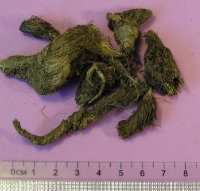 Jatamansi is an alpine annual plant with an aromatic rhizome. It is bitter, astringent and sweet in taste, strong and greasy in property, and cooling in action. It reduces Vata, Pitta and Kapha Dosha (defects). Its post-digestive action is pungent (katu), causing a drying effect in the colon. It is used as an anti-poison in swelling caused by toxins or gout and in malaria. It is also used as a calmative in formulas for high blood pressure, epilepsy and insomnia. It can be used for swelling in the throat and mouth. It is used as antispasmodic incense in asthma, hiccough, and cough and to calm the mind and brain. Overdose is emetic.
Jatamansi is an alpine annual plant with an aromatic rhizome. It is bitter, astringent and sweet in taste, strong and greasy in property, and cooling in action. It reduces Vata, Pitta and Kapha Dosha (defects). Its post-digestive action is pungent (katu), causing a drying effect in the colon. It is used as an anti-poison in swelling caused by toxins or gout and in malaria. It is also used as a calmative in formulas for high blood pressure, epilepsy and insomnia. It can be used for swelling in the throat and mouth. It is used as antispasmodic incense in asthma, hiccough, and cough and to calm the mind and brain. Overdose is emetic.
Jirakam seed (cumin / Cuminum cyminum)
Jirakam is a tropical spicy plant cultivated in plains areas. There are three varieties, small, large and black, all of which are used. Jirakam seed is pungent in taste, aromatic, dilatory (warming) in action, carminative and digestive, and used to purify the uterus. It is good in all food preparations, and helps to balance Vata energy. It is Grahi, a digestive and appetizing agent that causes heat and tightens the stool.
Jatiphalam seed (nutmeg / Myristica fragrans)
Jatiphalam is a tropical tree with aromatic nuts that grows in the south of India. It is bitter in taste, light to digest and greasy in property, and warm in action. It is carminative and stimulates digestion. It is used in diarrhea, nerve diseases, neuropathy, and throat defects. Externally used for skin disease. It can be used for bad breath and also plastered on sore gums.
Jivaka bulb (wild garlic / Allium wallichii, small)
Jivaka is an alpine bulbous herb that grows in the mountains. There are two varieties, small and large. The bulb is sweet in taste, rejuvenative, aphrodisiac, and is used in hemorrhage and to reduce Vata and Pitta.It is also used for rejuvenating effects and longevity. It is a frequently used herb in many internal and external applications. In ghee form, the bulb is used for traumatic eye injuries.
Kanchanara bark (mountain ebony / Bauhinia tomentosa)
Kanchanara is a sub-tropical, medium-sized tree. Its bark is astringent in taste and cold in action. It is sansodhanum, a body and blood purifying agent that excretes defective bile, mucus and gas. It is used in diarrhea, leprosy, glandular swelling and ulcers.
Kankola (long pepper, large / Piper cubeba)
Kankola is a sub-tropical and tropical creeper that grows in the forest, and is also cultivated. The aromatic fruit is bitter and pungent in taste, and heat producing in nature. It is good for Vata and Kapha diseases. It is used for heart diseases, mouth odor (halitosis) and is especially good used internally for eye diseases that cause blindness.
Kantakari herb (black nightshade / Solanum xanthocarpum)
Kantakari is an annual thorny plant. It has three varieties, with yellow, white, and red flowers. All are good medicine. All parts of the plant are bitter and astringent in taste and neutral in action. It is a diuretic, and is used in bronchitis, fever, colds, edema, chronic fever, anemia and hiccough. It is especially used for body pain. It reduces Vata and Kapha. The fruit and root are used in anemia.
Kapikacchu seeds (cowhage / Mucuna prurita)
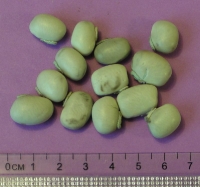 Kapikacchu is a tropical and sub-tropical climber with poisonous hairs on the pods. The seed is sweet and slightly bitter in taste, heavy to digest, rejuvenative and aphrodisiac (Vajikarana). It is used for impotence, for nerve disorders (Vata), and to help gain weight.
Kapikacchu is a tropical and sub-tropical climber with poisonous hairs on the pods. The seed is sweet and slightly bitter in taste, heavy to digest, rejuvenative and aphrodisiac (Vajikarana). It is used for impotence, for nerve disorders (Vata), and to help gain weight.
Karanja bark/seed oil (Indian beech / Pongamia pinnata)
Karanja is a tropical and sub-tropical tree that grows everywhere. Both bark and seed oil, taken internally, are good for nerve (Vata) disorders. The bark is pungent in taste, and is used in neurasthenia, abdominal tumor and worms. The seed oil is applied in skin diseases, in scabies, sores, herpes and eczema.
Karpura leaf/extract (camphor / Cinnamomum camphora)
Karpura is a perennial evergreen that grows to 100 feet. The crystallized extract of the leaf is bitter in taste, cold and refrigerant in action. It is used in mouth and throat diseases. It stimulates the bladder and skin in both internal and external uses.
Karchura tuber/seed (zedoary / Curcuma zedoaria)
Karchura grows on the shady sides of mountains in temperate climates. The tuber and seed are bitter-pungent in taste, light to digest and strong in property, and warming in action. They reduce Vata and Kapha. Both tuber and seed are carminative and digestive, and used in asthma and hiccough. The tuber is used for hemorrhoids, enteritis, swelling, typhoid fever, and coughs.
Karkatashringi fruit gall (insect gall on Pistacia intergerrima)
Karkatashringi is an “insect house” secretion attached to the Pistachio nut tree. It is pungent in taste, and hot in action. It reduces Kapha (mucus). It is a major Ayurvedic herb used for lung problems, asthma, tuberculosis, bronchitis and pleurisy. Also used for allergy, hay fever and neuralgic eye pain.
Kashmari bark/root/fruit (kashmarya / Gmelina arborea) Kashmari is a tropical and subtropical large trees. When cut it produces a latex that becomes red as it dries. The bark is astringent, bitter, and sweet in taste, and is heat producing in nature. It is good for fever, digestion, blood poisons, and leucorrhea. It increases semen and can be used in any complex (Sannipata) case.
Katuki rhizome (Indian gentian / Picrorhiza kurroa)
Katuki is an alpine annual herb. The rhizome is bitter and pungent in taste, and hot in action, as well as being laxative. It reduces Pitta and Kapha. It is a purgative agent that cleans the bowel (Bhedanam). It is very beneficial for fever.
Khadira extract (catechu / Acacia catechu, white)
Khadira is a tropical and sub-tropical small tree that grows in sandy areas and near rivers. A condensed extract made from a decoction of the bark, wood, flowering tops and gum. It is bitter and astringent in taste, light to digest and dry in property, and cooling in action. It reduces Kapha, for which it is frequently used. It is used externally as a paste to counteract mucus and swelling for all skin diseases, psoriasis, fungal infections and herpes. It is used for urinary frequency and is especially useful for Kapha urinary diseases. Also used for stomatitis or sore and spongy gums. The flower is used in hemorrhage.
Kinkirata flower (shahachara / Borlaria prionitis)
Kinkirata is an annual small plant that grows everywhere. It is bitter and pungent in taste, and good for blood purification and cancerous diseases.
Kiratatiktam plant (Swertia chirata)
Kiratatiktam is an alpine and sub-alpine mountainous plant. All parts of the plant are bitter in taste, and cold in action. It is especially good for fevers, for which it is used frequently. It reduces Kapha and Pitta.
Kovidara bark/flower (Bauhinia variegata)
Kovidara is a tropical and sub-tropical tree. The bark is astringent in taste and constrictory in action. It reduces Kapha. It is used for abnormal glandular swelling, scrofula, tumors and wound healing. It is always combined with Guggulu gum for use. The flower is sweet-astringent tasting, and used as an emetic. It is samsodhanam, an agent that cleans and excretes defective bile, mucus and gas.
Krisnajiraka seed (black cumin / Nigella sativa)
Krisnajirakam is an annual spicy cultivated tropical plant. The seed is pungent in taste, aromatic, carminative, and appetizing. Used in diarrhea and abdominal colic. Its action is similar to Jirakam (cumin).
Kuchila seed (purified nux vomica /Strychnos nux vomica)
Kuchila is a perennial large tree that grows in the tropical and sub-tropical climate. The seed is bitter in taste, hot in action, and poisonous. Purified seed is rejuvenative and used for indigestion, menorrhagia, back pain, rabies, twitching, lumbago and paralysis (oil form). Purify by first soaking in vinegar and cow urine for three days, then boil until red.
Kumari (Aloe leaf gum extract / Aloe barbadensis)
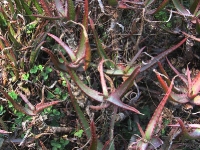 Kumari is a cultivated plant that grows everywhere. The leaf and gum extract is bitter in taste, and cooling (constrictory) in action. It is sticky, mobile, and heavy to digest in property. It is laxative, and an anti-poison. Used for enlargement of liver and spleen, burns, and amenorrhea.
Kumari is a cultivated plant that grows everywhere. The leaf and gum extract is bitter in taste, and cooling (constrictory) in action. It is sticky, mobile, and heavy to digest in property. It is laxative, and an anti-poison. Used for enlargement of liver and spleen, burns, and amenorrhea.
Kushtha root (Saussurea lappa)
Kushtha is a sub-alpine annual bush that grows especially in Kashmir. The root is bitter and pungent in taste, light to digest, dry and strong in property, and warming in action. It reduces Kapha and Vata. It is used for leprosy, gout and all skin diseases as an ointment made from powdered root. It can be used internally for fever, cough and poor appetite. It is also a stimulant, mild rejuvenative and anti-poison (visagna).
Kutaja bark/seed/leaf (indrayava (seed) / Holarrhena antidysenterica)
Kutaja is a small sub-tropical tree with pods. The bark, seed and leaf are bitter in taste, and cold in action. They reduce Pitta and Kapha. Kutaja is an agent that stops motion and bleeding (stambhanam). It is used to stop dysentery, fever and hemorrhoidal bleeding.
Lavangam seed (clove / Syzigium aromaticum)
Lavangam seed is pungent in taste, aromatic, carminative and digestive. The seed can be held in the mouth after meals to refresh and purify the mouth, and also for dental problems. It is good for acid producing diseases. It is beneficial in winter meat preparations.
Madhukam root (licorice / Glycyrrhiza glabra)
Madhukam is a perennial climber. The root is sweet in taste, heavy to digest and greasy in property, and cooling in action. It reduces Pitta and Vata. It is a Rasayana, an expectorant and an anti-poison. It promotes good eyesight, clear voice and clean complexion. It is used for sore throat, hypertension and ulcers. Continual use for 2-3 days can reduce pain. It is useful to sweeten herbal formulas.
Mahabala (Sida cordifolia,white)
Mahabala is an annual small plant with white flowers that grows in dry areas. Mahabala is sweet in taste, heavy and greasy in quality, and cold in action. It is part of the bala group. It reduces Vata and Pitta. It is especially used in urinary disorders.
Mahanimba leaf/flower/seed (Persian lilac / Melia azadirachta)
Mahanimba is a medium sized tree. The leaf is bitter in taste and cooling in action, and reduces Kapha and Pitta. It is used to cure malaria fever. The flower is used for pain and headache. The seed is mildly poisonous, and used for leprosy and worms. It is good for any skin disease.
Maricham seed (black pepper / Piper nigrum)
Maricham is a tropical climber that grows in the shade. The fruit is pungent in taste, hot in action, appetizing and digestive. It reduces Vata and Kapha. It is used for colic pain, worms, cough, and asthma. It helps to digest minerals. It is Suksmam, an agent that enters the micro-tissues. It is chedanam, an expectorant agent that promotes release of mucus attached to the ducts.
Methika seed (fenugreek / Trigonella foenum-graecum)
Methika seed is bitter in taste, warming in action, easy to digest and an appetite stimulant. It is useful in cases of fever, blood impurity and cancer. It is anthelmintic (kills worms), and is good for diabetes.
Murva plant/root (Bauhinia vahli)
Murva is a tropical and sub-tropical forest climber. All parts of the plant are bitter and sweet in taste. Used in skin diseases and to reduce Pitta. The root is used in pulmonary tuberculosis.
Musali tuber (Curculigo orchioides)
Musali is a tropical and sub-tropical tuberous herb that grows on hills. The tuber is sweet in taste, cooling, restorative and aphrodisiac. It is useful for increasing weight, and is used for its nourishing effects in tuberculosis, atrophy, over-balanced nervous system (Vata), weight loss, atrophy, impotence etc.
Musta tuber (nut grass / mustaka / Cyperus rotundus, large)
Musta is a tuberous grassy plant tuber grows in tropical climates. There are three varieties called musta (large tuber), kasheruka and nagara. The large tuber is bitter and astringent in taste, cooling in action, digestive and appetizing. It is light to digest and dry in property. It reduces Pitta and Kapha. It is used for diarrhea, sprue, dysentery, enteritis, edema, and fever.
Nagabala (Sida spinosa, wild)
Nagabala is an annual plant with yellow flowers. It is sweet in taste and cooling in action. It is part of the bala group. Nagabala is used especially for blood defects and also has an aphrodisiac effect. Excessive use causes constipation, bloated stomach, and weight loss.
Nagakesara seed/flower (ironwood tree / Mesua ferrea)
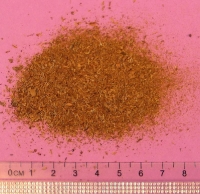 Nagakesara is a middle sized evergreen tree that grows in the sub-alpine climate, especially the eastern Himalayan range. The seed is pungent in taste. Used as an anti-poison in throat defects, hay fever and diseases of the head.
Nagakesara is a middle sized evergreen tree that grows in the sub-alpine climate, especially the eastern Himalayan range. The seed is pungent in taste. Used as an anti-poison in throat defects, hay fever and diseases of the head.
Nagaram rhizome (Indian cyperus / Cyperus pertenuis)
Nagaram is a tropical and sub-tropical annual tall grassy plant with tuberous rhizome that grows in swampy areas. There are three varieties called musta, kasheruka and nagara. The rhizome is bitter and pungent in taste, used as a carminative and digestive in constipation, abdominal colic pain, fever, typhoid fever, liver and spleen defects, and to reduce Vata and Kapha.
Nimba leaf (neem / Azadirachta indica)
Nimba is a tropical and sub-tropical small sized tree that grows in plains areas. Neem leaf is bitter in taste, light in property, and cooling in action. The post-digestive action is pungent (katu), causing a drying effect. It reduces Kapha and Pitta. It is used in all skin diseases, especially to reduce swelling and itching. It is also used for fever, malaria in particular, as well as for leprosy, toxemia, and allergies. It is used internally and externally for all forms of fungal infection. Externally it is used to heal wounds, boils and other skin problems.
Padmam plant/seed (white lotus / Nelumbo nucifera)
Lotus comes in many varieties: white lotus is Padmam, red is Raktotpalam, and blue is Nilotpalam. The taste is astringent, bitter, and sweet and it is cooling in effect. It causes constipation, increases gas, and is good for Kapha and Pitta. The seed is good for infertility.
Palasha seed/flower/alkali (bastard teak / Butea frondosa)
Palasha is a subtropical tree that grows in mountainous areas. The seed is pungent in taste, and used in worms and toxemia. The flower is pungent and astringent in taste and used in hemorrhage. The alkali extracted from the bark ash is used in hemorrhage and menorrhagia.
Parpata herb (Fumaria indica)
Parpata is a small annual herb that grows in wheat farms. All parts of the plant are bitter in taste, and cooling in action. It reduces Pitta. It is used for fever and is good for dehydration (increases fluids) it can be combined with Chandana wood (white sandalwood / Santalum album) to make a basic anti-Pitta formula.
Pashanabheda root (rockfoil / Bergenia ligulata)
Pasanbheda is a perennial herb with rhizome that grows in rocky mountainous areas. Its root is bitter and astringent in taste, and warming. It is diuretic and reduces Pitta. Used for kidney and bladder stones, painful urination, dysuria, and urinary system infection.
Patala root/bark (Stereospermum personatum)
Patala is a large sub-tropical tree. The root and bark are bitter in taste. It is a rejuvenative and alterative. Used in edema and to reduce Vata.
Patha root (Stephania hernandifolia)
Patha is an annual climber with tuber that grows in temperate forests. The tuber is bitter in taste. Used in fever, typhoid fever, diarrhea, chronic diarrhea, hemorrhage, throat defects, and anemia caused by clay-eating. It reduces Vata and Pitta.
Patram leaf (Cassia cinnamon / Cinnamomum tamala)
Patram is a temperate and sub-tropical evergreen tree with aromatic leaves. The leaf is bitter and pungent in taste, and an alterative for immunity. Used in respiratory diseases, coughs, hemoptysis, nose defects, gout, edema, toxemia, and skin diseases.
Pippali fruit/root (long pepper / Piper longum)
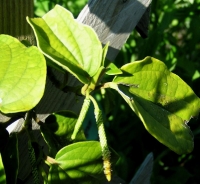 Pippali is a sub-tropical and tropical creeper that grows in the forest, and is also cultivated. It is grouped with Pippali, Gajapippali and Chavyam, all of which share similar effects. The fruit is pungent in taste, appetizing, and digestive. It reduces Vata and Kapha. It is used in bronchitis, asthma, cough and fever. It stimulates the medicinal effects of other herbs, has restorative qualities and is good for long life. The root is pungent in taste, light in quality and aids in food digestion. It is good for stomach diseases, liver and spleen diseases, and tuberculosis.
Pippali is a sub-tropical and tropical creeper that grows in the forest, and is also cultivated. It is grouped with Pippali, Gajapippali and Chavyam, all of which share similar effects. The fruit is pungent in taste, appetizing, and digestive. It reduces Vata and Kapha. It is used in bronchitis, asthma, cough and fever. It stimulates the medicinal effects of other herbs, has restorative qualities and is good for long life. The root is pungent in taste, light in quality and aids in food digestion. It is good for stomach diseases, liver and spleen diseases, and tuberculosis.
Punarnava plant/root (Boerhavia difusa)
Punarnava is an annual spreading plant that grows well in sub-tropical forests. It has two varieties, one with red stem and one with green stem. All parts of the plant are bitter in taste, constrictory in action, diuretic and alterative. It reduces Kapha and Pitta. It is used for painful urination (caused by bladder or kidney stone), edema, gout, and anemia. When prepared with bone marrow soup it becomes a Rasayana. It is also used for hemorrhoids, and for bleeding in the lungs and uterus. The plant with red stem is more effectively used in coughs, hemoptysis and menorrhagia.
Rakta Chandanam wood (red sandalwood / Pterocarpus santalinus)
Rakta Chandanam is a woody tropical tree. The wood is bitter in taste and constrictory in action. It is an anti-poison (visaghna), refrigerant, and anti-toxin used in fevers and to reduce Pitta. Good for dizziness caused by high or low blood pressure. It can be used by itself or combined with Parpata herb (Fumaria indica) as a basic anti-Pitta formula for up to three months. Combine with Chandanam wood (white sandalwood / Santalum album) for menopausal hot flashes.
Rasna shrub (Vanda roxburghii)
Rasna is a perennial shrub that grows on hills in temperate and sub-tropical hills. All parts of the plant are bitter in taste, heavy to digest, and heat producing in nature. It reduces Vata. Used internally and externally in medicated oils for any kind of Vata disorder.
Rohitaka stem (rhododendron / Rhododendron arboreum)
Rohitaka (Rhododendron arboreum) is an alpine and sub-alpine small tree with red flowers. The stem is pungent in taste, and is used in enlargement of liver and spleen. It reduces Pitta. The root is pungent in taste, and used in leucorrhea. It is mildly poisonous.
Sarpagandha root (Rauwolfia serpentina)
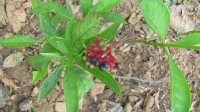 Sarpagandha is a tropical bushy annual plant, found especially in eastern Nepal. The root is bitter in taste and cool in action. It reduces Vata and Pitta. It is used for hypertension and insomnia. It is not a cure, but causes quick blood pressure reduction over 4 to 6 hours.
Sarpagandha is a tropical bushy annual plant, found especially in eastern Nepal. The root is bitter in taste and cool in action. It reduces Vata and Pitta. It is used for hypertension and insomnia. It is not a cure, but causes quick blood pressure reduction over 4 to 6 hours.
Shalaparni plant (Desmodium gangeticum)
Shalaparni is a sub-tropical perennial spreading herb that grows on dry hills. All parts of the plant are sweet in taste, with a mild heat-generating property. It is used as a restorative, aphrodisiac and alterative to increase immunity. It has a sedative effect, especially in the brain. It is used in fever, and to reduce Vata, Pitta and Kapha. It has the unique effect (prabhava) of reducing imbalance without ever causing over-balance. It is used in difficult to control diseases like typhoid fever and tuberculosis.
Shatavari root (wild asparagus / Asparagus racemosus)
Shatavari root is a tropical and sub-tropical, thorny, perennial, and tuberous shrub. The root is sweet and bitter in taste, cooling (refrigerant) in action, and heavy to digest and greasy in property. It reduces Vata and Pitta dosha. It is used for gout, hemorrhoids, and bleeding in the urine, as well as inflammation or bleeding from the lung, stomach or uterus. In large dose, it can be used to control blood pressure. It is a brain restorative (Vata), used in epilepsy and hypertension. It strengthens the heart and the Ojas (vital water), and is used in inflammatory heart and liver diseases. It promotes fertility and breast milk in women.
Suksmaila seed (cardamom / Elettaria cardamomum)
Suksmaila seed is a perennial rhizomatous plant cultivated in temperate and sub-tropical valleys. The seed is pungent in taste, aromatic, and has a cooling sensation. It is carminative, appetizing, sedative and an aid to digestion. It is used as a mild anti-poison in body ache, coughs, and vomiting. It is a good spice for bean and meat preparations, and can be used after meals for its pleasant aroma.
Sunthi root (dry ginger / Zingiber officinalis)
Sunthi is an erect cultivated perennial spicy plant with thick tubers. It is pungent in taste, carminative, digestive, and aphrodisiac. It is cooling in action. It is light to digest and strong in property. It reduces Kapha and Vata. It is used for urticaria, common cold, allergies and rheumatism. Its post-digestive action is sweet (madhura), increasing its nourishing qualities, creating a mild aphrodisiac effect as well as aiding in peristaltic movement. Fresh ginger is called Adrakam.
Surana tuber (shurana / telugo potato / Amorphophallus campanulatum)
Surana is an annual tuberous plant that grows in shady forest areas. The tuber is pungent in taste, hot in action, stomachic, carminative and restorative. Used in hemorrhoids and abdominal tumors.
Swarnapatri leaf (senna / Cassia auriculata, C. angustifolia)
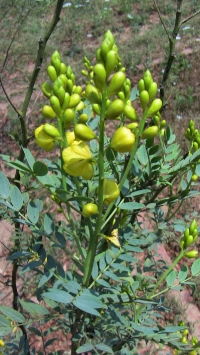 Swarnapatri leaf is annual plant with alterate pinnate leaves that grows in tropical climates in plains areas, especially in South India. Its leaf is bitter in taste, and used as a laxative in excess Pitta.
Swarnapatri leaf is annual plant with alterate pinnate leaves that grows in tropical climates in plains areas, especially in South India. Its leaf is bitter in taste, and used as a laxative in excess Pitta.
Talisam leaf (rhododendron / Rhododendron stesum)
Talisam is an alpine small bushy plant with aromatic leaves. The leaf is bitter and sweet in taste. Used in pulmonary tuberculosis, asthma, hay fever and cough, tumor, and anorexia.
Tila seed/oil (sesame / Sesamum indicum)
Tila is a cultivated spice. It is pungent, bitter, sweet and astringent in taste. It is very good in Vata diseases, internally or externally, and is especially good for skin problems. The oil benefits the hair and teeth, and can be used for cuts and wounds. It can decrease the force of urine if taken in excess.
Trivrit root (Indian rhubarb /Operculina turpenthum)
Trivrit is a milky climber that grows in the temperate forest. Its root is pungent in taste and cold in action. It causes liquid stools (Rechanum). It reduces Pitta, and is the best laxative for Pitta conditions. It is used in fevers.
Twak bark (cinnamon / Cinnamomum zeylanicum)
Twak is a tropical and sub-tropical evergreen tree with aromatic bark. The bark is sweet and pungent in taste, and warm in action. It has a cooling after-effect in the mouth. It is a carminative and a digestive, a mild anti-poison, and reduces Kapha and Vata. It is used in coughs, heart disease, loss of appetite, rheumatism and sinusitis. It is good in all vegetable preparations.
Ushira rhizome (Andropogon muricatum)
Ushira is a tall grassy plant with fragrant rhizome that grows in the sub-tropical swampy forest. The rhizome is bitter in taste, and reduces Pitta. It is used as a refrigerant for fever and thirst.
Vacha rhizome (acorus / Acorus calamus)
Vacha is a perennial aromatic herb that grows in muddy ponds. The rhizome is pungent and slightly bitter in taste, warming and drying in action, and light to digest and strong in property. It reduces Kapha and Vata. Its special power (Prabhava) is epilepsy, and it is medhya (improves memory and intellect). It is used in epilepsy, insanity, as a brain and longevity restorative, and for loss of memory. It increases the digestive fire (Agni). It is Lekhanam, an agent that causes dryness, and promotes expectoration of mucus. It improves blood circulation to the brain and drains the ducts. In large doses it is an emetic. It can be chewed and sucked for hoarseness.
Vakuchi seed (Psoralia corylifolia)
Vakuchi is an annual bushy plant cultivated everywhere. The oily aromatic seed is bitter and pungent in taste, and hot in action. It is used in all skin diseases, eczema, leprosy, psoriasis and leucoderma.
Vamsalochana (Bamboo manna / Bambusa breviflora)
Vamsalochana is a perennial tree that grows in tropical climates. It contains white manna which is sweet-astringent in taste and which reduces Pitta. It is used in asthma and cough.
Vasaka leaf/root/flower (Malabar nut / Adhatoda vasica)
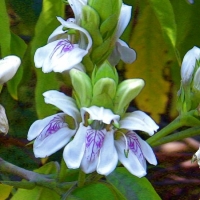 Vasaka is a perennial evergreen bush which grows everywhere in dry areas. The leaf is bitter and astringent in taste, light to digest and dry in property, and cooling in action. Its post-digestive action is pungent (Katu), causing a drying effect in the colon. It reduces Kapha and Pitta. It is used for hemorrhoids, hemoptitis, and blood in the lungs (hemorrhage or tuberculosis), hepatitis, fever, asthma, cough, and chronic bronchitis. Fresh leaf juice with honey and/or ginger can be used for cough. The root and flower are bitter in taste and used in inflammatory abdominal tumor.
Vasaka is a perennial evergreen bush which grows everywhere in dry areas. The leaf is bitter and astringent in taste, light to digest and dry in property, and cooling in action. Its post-digestive action is pungent (Katu), causing a drying effect in the colon. It reduces Kapha and Pitta. It is used for hemorrhoids, hemoptitis, and blood in the lungs (hemorrhage or tuberculosis), hepatitis, fever, asthma, cough, and chronic bronchitis. Fresh leaf juice with honey and/or ginger can be used for cough. The root and flower are bitter in taste and used in inflammatory abdominal tumor.
Vidanga seeds (Embelia ribes)
Vidanga is an evergreen small sized tree that grows in temperate forests. The seed is pungent in taste and hot in action. It reduces Kapha and is used frequently to reduce mucus. It kills parasites (krimighna), and is used for leprosy, abdominal tumors and sprue.
Yavani seed (wild omum / ajagandha / Trachyspermum ammi)
Yavani is a spicy cultivated plant. The seed is bitter and pungent in taste, carminative, digestive and appetizing. It reduces Vata and Kapha. Used in colds, urticaria, heart pain, bladder pain and abdominal colic. Also used in skin diseases. Used extensively for treatment of the common cold in tea form.
0 Responses to “Review of Ayurvedic Medicines – Herbs and Foods”